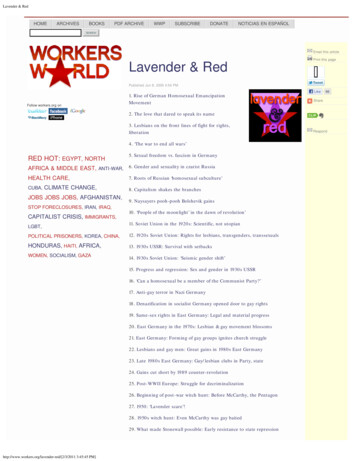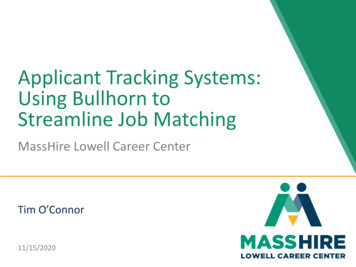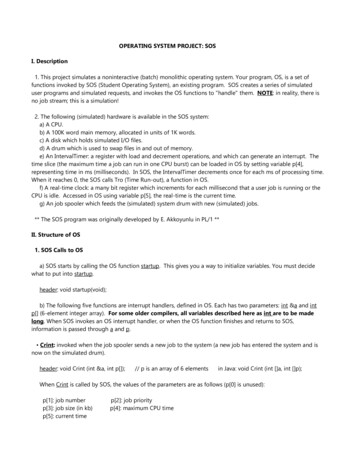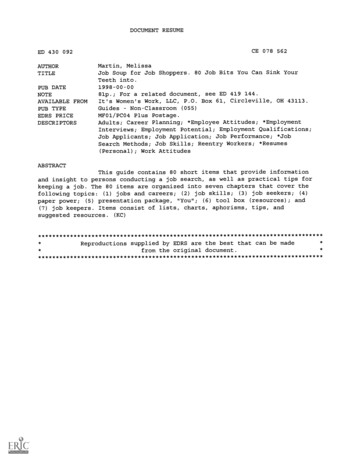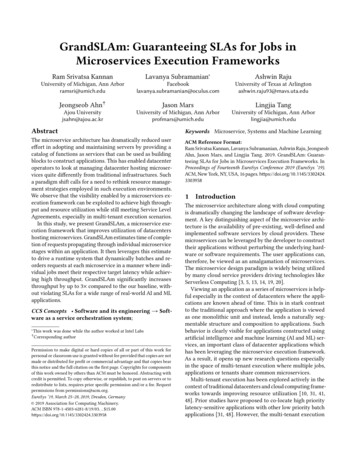
Transcription
GrandSLAm: Guaranteeing SLAs for Jobs inMicroservices Execution FrameworksRam Srivatsa KannanLavanya Subramanian Ashwin RajuUniversity of Michigan, Ann culus.comUniversity of Texas at Arlingtonashwin.raju93@mavs.uta.eduJeongseob Ahn†Jason MarsLingjia TangAjou Universityjsahn@ajou.ac.krUniversity of Michigan, Ann Arborprofmars@umich.eduUniversity of Michigan, Ann Arborlingjia@umich.eduAbstractKeywords Microservice, Systems and Machine LearningThe microservice architecture has dramatically reduced usereffort in adopting and maintaining servers by providing acatalog of functions as services that can be used as buildingblocks to construct applications. This has enabled datacenteroperators to look at managing datacenter hosting microservices quite differently from traditional infrastructures. Sucha paradigm shift calls for a need to rethink resource management strategies employed in such execution environments.We observe that the visibility enabled by a microservices execution framework can be exploited to achieve high throughput and resource utilization while still meeting Service LevelAgreements, especially in multi-tenant execution scenarios.In this study, we present GrandSLAm, a microservice execution framework that improves utilization of datacentershosting microservices. GrandSLAm estimates time of completion of requests propagating through individual microservicestages within an application. It then leverages this estimateto drive a runtime system that dynamically batches and reorders requests at each microservice in a manner where individual jobs meet their respective target latency while achieving high throughput. GrandSLAm significantly increasesthroughput by up to 3 compared to the our baseline, without violating SLAs for a wide range of real-world AI and MLapplications.ACM Reference Format:Ram Srivatsa Kannan, Lavanya Subramanian, Ashwin Raju, JeongseobAhn, Jason Mars, and Lingjia Tang. 2019. GrandSLAm: Guaranteeing SLAs for Jobs in Microservices Execution Frameworks. InProceedings of Fourteenth EuroSys Conference 2019 (EuroSys ’19).ACM, New York, NY, USA, 16 pages. https://doi.org/10.1145/3302424.3303958CCS Concepts Software and its engineering Software as a service orchestration system; Thiswork was done while the author worked at Intel Labsauthor† CorrespondingPermission to make digital or hard copies of all or part of this work forpersonal or classroom use is granted without fee provided that copies are notmade or distributed for profit or commercial advantage and that copies bearthis notice and the full citation on the first page. Copyrights for componentsof this work owned by others than ACM must be honored. Abstracting withcredit is permitted. To copy otherwise, or republish, to post on servers or toredistribute to lists, requires prior specific permission and/or a fee. Requestpermissions from permissions@acm.org.EuroSys ’19, March 25–28, 2019, Dresden, Germany 2019 Association for Computing Machinery.ACM ISBN 978-1-4503-6281-8/19/03. . . ductionThe microservice architecture along with cloud computingis dramatically changing the landscape of software development. A key distinguishing aspect of the microservice architecture is the availability of pre-existing, well-defined andimplemented software services by cloud providers. Thesemicroservices can be leveraged by the developer to constructtheir applications without perturbing the underlying hardware or software requirements. The user applications can,therefore, be viewed as an amalgamation of microservices.The microservice design paradigm is widely being utilizedby many cloud service providers driving technologies likeServerless Computing [3, 5, 13, 14, 19, 20].Viewing an application as a series of microservices is helpful especially in the context of datacenters where the applications are known ahead of time. This is in stark contrastto the traditional approach where the application is viewedas one monolithic unit and instead, lends a naturally segmentable structure and composition to applications. Suchbehavior is clearly visible for applications constructed usingartificial intelligence and machine learning (AI and ML) services, an important class of datacenter applications whichhas been leveraging the microservice execution framework.As a result, it opens up new research questions especiallyin the space of multi-tenant execution where multiple jobs,applications or tenants share common microservices.Multi-tenant execution has been explored actively in thecontext of traditional datacenters and cloud computing frameworks towards improving resource utilization [10, 31, 41,48]. Prior studies have proposed to co-locate high prioritylatency-sensitive applications with other low priority batchapplications [31, 48]. However, the multi-tenant execution
EuroSys ’19, March 25–28, 2019, Dresden, GermanyLatencystage 1120010008006004002000stage 2Image solo0500stage 3Image colo100015002000RS Kannan et al.stage 4SLA2500Requests served300035004000(a) Image Querying: SLA is not violatedStage 1Stage 2Stage 3Stage 4QuestionAnsweringText to SpeechinputImage RecognitionNatural LanguageUnderstandinginputOutputSpeech RecognitionOutputLatency(b) Sharing NLU and QA stage 10500stage 210001500IPA soloIPA coloSLAstage 320002500Requests served300035004000(c) IPA: SLA is violatedFigure 1. Sharing the two common microservices betweenImage Querying and Intelligent Personal Assistant applicationsin a microservice based computing framework would operate on a fundamentally different set of considerations andassumptions since resource sharing can now be viewed at amicroservice granularity rather than at an entire applicationgranularity.Figure 1b illustrates an example scenario in which anend-to-end Intelligent Personal Assistant (IPA) applicationshares the Natural Language Understanding (NLU) andQuestion Answering (QA) microservices with an imagebased querying application. Each of these applications isconstructed as an amalgamation of different microservices(or stages). In such a scenario, the execution load in theseparticular microservices increases, thereby causing the latency of query execution in stages 2 and 3 to increase. Thisincrease in latency at specific stages affects the end-to-endlatency of the IPA application, thereby violating service levelagreements (SLAs). This phenomenon is illustrated by Figure 1c and Figure 1a. The x-axis represents the number ofrequests served while the y-axis denotes latency. Horizontaldotted lines separate individual stages. As can be seen, theSLA violation for the image querying application in Figure 1ais small, whereas the IPA application suffers heavily fromSLA violation. However, our understanding of the resourcecontention need not stop at such an application granularity, unlike traditional private data centers. It can rather bebroken down into contention at the microservice granularity, which makes resource contention management a moretractable problem.This fundamentally different characteristic of microservice environments motivates us to rethink the design ofruntime systems that drive multi-tenancy in microservice execution frameworks. Specifically, in virtualized datacenters,consolidation of multiple latency critical applications is limited, as such scenarios can be performance intrusive. In particular, the tail latency of these latency critical applicationscould increase significantly due to the inter-application interference from sharing the hardware resources [31, 32, 48, 51].Even in a private datacenter, there is limited visibility intoapplication specific behavior and SLAs, which makes it hardeven to determine the existence of such performance intrusion [27]. As a result, cloud service providers would not beable to meet SLAs in such execution scenarios that co-locatemultiple latency critical applications. In stark contrast, theexecution flow of requests through individual microservicesis much more transparent.We observe that this visibility creates a new opportunityin a microservice-based execution framework and can enablehigh throughput from consolidating the execution of multiple latency critical jobs, while still employing fine-grainedtask management to prevent SLA violations. In this context,satisfying end-to-end SLAs merely becomes a function ofmeeting disaggregated partial SLAs at each microservicestage through which requests belonging to individual jobspropagate. However, focusing on each microservice stage’sSLAs standalone misses a key opportunity, since we observethat there is significant variation in the request level execution slack among individual requests of multiple jobs. Thisstems from the variability that exists with respect to userspecific SLAs, which we seek to exploit.In this study, we propose GrandSLAm, a holistic runtimeframework that enables consolidated execution of requestsbelonging to multiple jobs in a microservice-based computing framework. GrandSLAm does so by providing a prediction based on identifying safe consolidation to deliver satisfactory SLA (latency) while maximizing throughput simultaneously. GrandSLAm exploits the microservice executionframework and the visibility it provides especially for AI andML applications, to build a model that can estimate the completion time of requests at different stages of a job with highaccuracy. It then leverages the prediction model to estimateper-stage SLAs using which it (1) ensures end-to-end joblatency by reordering requests to prioritize those requestswith low computational slack, (2) batches multiple requeststo the maximum extent possible to achieve high throughputunder the user specified latency constraints. It is importantto note that employing each of these techniques standalonedoes not yield SLA enforcement. An informed combination
Guaranteeing SLAs for Jobs in Microservice Execution Frameworksof request re-ordering with a view of end-to-end latencyslack and batching is what yields effective SLA enforcement,as we demonstrate later in the paper. Specifically, this papermakes the following contributions: Analysis of microservice execution scenarios. Ourinvestigation observes the key differences between traditional and microservice-based computing platforms –primarily in the context of visibility into the underlyingmicroservices that provide exposure to application specific SLA metrics. Accurate estimation of completion time at individual microservice stages. We build a model that estimates the completion time of individual requests at thedifferent microservice stages and hence, the overall timeof completion. We have demonstrated high accuracy inestimating completion times, especially for AI and MLmicroservices. Guarantee end-to-end SLAs by exploiting stage levelSLAs. By utilizing the completion time predictions fromthe model, we derive individual stage SLAs for each microservice/stage. We then combine this per-stage SLA requirement with our understanding of end-to-end latencyand slack. This enables an efficient request schedulingmechanism towards the end goal of maximizing serverthroughput without violating the end-to-end SLA.Our evaluations on a real system deployment of a 6 nodeCPU cluster coupled with graphics processing acceleratorsdemonstrates GrandSLAm’s capability to increase the throughput of a datacenter by up to 3 over the state-of-the-art request execution schemes for a broad range of real-world applications. We perform scale-out studies as well that demonstrate increased throughput while meeting SLAs.2BackgroundIn this section, we first describe the software architectureof a typical microservice and its execution framework. Wethen describe unique opportunities a microservice framework presents as compared to a traditional datacenter, foran efficient redesign.2.1Microservices Software ArchitectureThe microservice architecture is gaining popularity amongsoftware engineers, since it enables easier application development and deployment while not having to worry about theunderlying hardware and software requirements. Microservices resemble well-defined libraries that perform specificfunctions, which can be exposed to consumers (i.e., application developers) through simple APIs. With the microservice paradigm approach, instead of writing an applicationfrom scratch, software engineers leverage these microservices as building blocks to construct end-to-end applications.The end-to-end applications consist of a chain of microservices many of which are furnished by the datacenter serviceEuroSys ’19, March 25–28, 2019, Dresden, Germanyproviders. Microservice based software architectures speedup deployment cycles, foster application-level innovationby providing a rich set of primitives, and improve maintainability and scalability, for application classes where thesame building blocks tend to be used in many applicationcontexts [13].Traditional, multi-tier architectures compartmentalize application stages based on the nature of services into different tiers. In most cases, application stages belong to eitherthe presentation layer which focuses on the user interface,application processing layer in which the actual application execution occurs and the data management layer whichstores data and metadata belonging to the application. This isfundamentally different from the microservice architecture.Microservices, at each stage in a multi-stage application, perform part of the processing in a large application. In otherwords, one can imagine a chain of microservices to constitutethe application processing layer.2.2Microservices Use CasesWith the advent of Serverless Computing design, the microservices paradigm is being viewed as a convenient solution for building and deploying applications. Several cloudservice providers like Amazon (AWS Lambda [3]) and IBM(IBM Bluemix [29]) utilize the microservice paradigm to offer services to their clients. Typically, microservices hostedby cloud service providers provide the necessary functionality for each execution stage in every user’s multi-stageapplication. In this context, a motivating class of applications that would benefit from the microservice paradigmis artificial intelligence (AI) and machine learning (ML) applications [39]. Many of the stages present in the execution pipeline of AI applications are common across otherAI applications [13]. As shown in the example in Figure 1b,a speech-input based query execution application is constructed as an amalgamation of microservices that performsspeech recognition, natural language understanding, and aquestion answering system. Similarly, an image-input basedquery system/application also uses several of these samemicroservices as its building blocks.FaaS (Function-as-a-Service) or Serverless based cloudservices contain APIs to define the workflow of a multistage application as a series of steps representing a DirectedAcyclic Graph (DAG). For instance, some of the workflowtypes (DAGs) that are provided by Amazon as defined byAWS step functions [4] are shown in Figure 2. Elgamal etal. talk about this in detail [11]. Figure 2 (a) shows the simplest case where the DAG is sequential. From our study, wewere able to find that several real-world applications (Applications Table 3) and customers utilizing AWS Lambdapossess workflow DAGs there were sequential. Figure 2 (b)shows a workflow DAG with parallel steps in which multiple functions are executed in parallel, and their outputs areaggregated before the next function starts. The last type of
λ2λ2λ21600120080040000 8 16 24 32Sharing degree160120804000 8 16 24 32Sharing degreeLatency (ms)λ1Throughput (QPS)λ1λ1RS Kannan et al.Latency (ms)EuroSys ’19, March 25–28, 2019, Dresden, Germany600040002000064128 256Input sizeλ3λ3λ4(a) Latencyλ5λ4λ5(a) Sequential DAGs(b) Parallel DAGsλ4workflow DAGs possesses branching steps shown in Figure 2(c). Such workflows typically have a branch node that has acondition to decide in which direction the branch executionwould proceed. In our paper, we focus only on sequentialworkflows as shown in Figure 2 (a). In Section 5, we willdiscuss the limitation of our study and possible extensionsfor the complex workflows.ChallengesAlthough the usage and deployment of microservices are fundamentally different from traditional datacenter applications,the low resource utilization problem persists even in datacenters housing microservices [15, 16, 40]. In order to curb this,datacenter service providers could potentially allow sharingof common microservices across multiple jobs as shown inFigure 1b. However, these classes of applications, being userfacing, are required to meet strict Service Level Agreements(SLAs) guarantees. Hence, sharing microservices could createcontention, resulting in the violation of end-to-end latency ofindividual user-facing applications, thereby violating SLAs.This is analogous to traditional datacenters where there is atendency to actively avoid co-locating multiple user-facingapplications, leading to over-provisioning of the underlyingresources when optimizing for peak performance [6].2.4(c) Input sizeFigure 3. Increase in latency, throughput, and input size asthe sharing degree increases(b) Branching DAGsFigure 2. Types of DAGs used in applications based on microservices2.3(b) ThroughputOpportunitiesHowever, the microservice execution environments fundamentally change several operating assumptions present intraditional datacenters that enable much more efficient multitenancy, while still achieving SLAs. First, the microserviceexecution framework enables a new degree of visibility intoan application’s structure and behavior, since an application is comprised of microservice building blocks. This isdifferent from traditional datacenter applications where theapplication is viewed as one monolithic unit. Hence, in sucha traditional datacenter, it becomes very challenging to evenidentify, let alone prevent interference between co-runningapplications [27, 31, 48]. Second, the granularity of multitenancy and consolidation in a microservice framework isdistinctively different from traditional datacenter systems.Application consolidation in microservice execution platforms is performed at a fine granularity, by batching multiple requests belonging to different tenants, to the samemicroservice [16]. On the other hand, for traditional datacenter applications, multi-tenancy is handled at a very coarsegranularity where entire applications belonging to differentusers are co-scheduled [27, 31, 44, 45, 48]. These observationsclearly point to the need for a paradigm shift in the designof runtime systems that can enable and drive multi-tenantexecution where different jobs share common microservicesin a microservice design framework.Towards rethinking runtime systems that drive multitenancy in microservice design frameworks, we seek to identify and exploit key new opportunities that exist, in thiscontext. First, the ability to accurately predict the timeeach request spends at a microservice even prior toits execution opens up a key opportunity towards performing safe consolidations without violating SLAs.This, when exploited judiciously, could enable the sharingof microservices that are employed across multiple jobs,achieving high throughput, while still meeting SLAs. Second, the variability existing in SLAs when multiple latency sensitive jobs are consolidated generates a lot ofrequest level execution slack that can be distributedacross other requests. In other words, consolidated execution is avoided for requests with low execution slack and viceversa. These scenarios create new opportunities in the microservice execution framework to achieve high throughputby consolidating the execution of multiple latency sensitive jobs, while still achieving user-specific SLAs, throughfine-grained task management.3Analysis of MicroservicesThis section investigates the performance characteristicsof emerging AI and ML services utilizing the pipelined microservices. Using that, we develop a methodology that canaccurately estimate completion time for any given request ateach microservice stage prior to its execution. This information becomes beneficial towards safely enabling fine-grainedrequest consolidation when microservices are shared amongdifferent applications under varying latency constraints.
Guaranteeing SLAs for Jobs in Microservice Execution FrameworksPerformance of MicroservicesIn this section, we analyze three critical factors that determine the execution time of a request at each microservicestage: (1) Sharing degree (2) Input size (3) Queuing delay. For this analysis, we select a microservice that performsimage classification (IMC) which is a part of the catalogof microservices offered by AWS Step Functions [39].(1) Sharing degree. Sharing degree defines the granularityat which requests belonging to different jobs (or applications) are batched together for execution. A sharing degreeof one means that the microservice processes only one request at a time. This situation arises where a microserviceinstance executing a job restricts sharing its resources simultaneously for requests belonging to other jobs. Requestsunder this scheme can achieve low latency at the cost of lowresource utilization. On the other hand, a sharing degree ofthirty indicates that the microservice merges thirty requestsinto a single batch to process the requests belonging different jobs simultaneously. Increasing the sharing degree hasdemonstrated to increase the occupancy of the underlyingcomputing platform (especially for GPUs) [16]. However, ithas a direct impact on the latency of the executing requestsas the first request arriving at the microservice would endup waiting until the arrival of the 30th request when thesharing degree is 30.Figures 3a and 3b illustrate the impact of sharing degreeon latency and throughput. The inputs that we have used forstudying this effect is a set of images with dimension 128x128.The horizontal axes on both figure 3a and 3b represent thesharing degree. The vertical axis in figure 3a and 3b represents latency in milliseconds and throughput in requests persecond respectively. From figures 3a and 3b, we can clearlysee that the sharing degree improves throughput. However,it affects the latency of execution of individual requests aswell.(2) Input size. Second, we observe changes in the executiontime of a request by varying its input size. As the inputsize increases, additional amounts of computation would beperformed by the microservices. Hence, input sizes play akey role in determining the execution time of requests. Tostudy this using the image classification (IMC) microservice,we obtain request execution times for different input sizesof images from 64x64 to 256x256. The sharing degree is keptconstant in this experiment. Figure 3c illustrates the findingsof our experiment. We observe that as input sizes increase,execution time of requests also increase. We also observedsimilar performance trends for other microservice types.(3) Queuing delay. Queuing delay is the last factor thataffects execution time of requests. This is experienced byrequests waiting on previously dispatched requests to becompleted. From our analysis, we observe that there is alinear relationship between the execution time of a requestIMCError (%)3.1EuroSys ’19, March 25–28, 2019, Dresden, GermanyFACEDFACER303030202020101010000 10 10 10 20 20 20 300246810Small input1214 302468101214 30HS2Medium input468101214Large inputFigure 4. Error(%) in predicting ETC for different input sizeswith increase in the sharing degree (x-axis)its sharing degree and input size respectively. Queuing delay can be easily calculated at runtime using the executionsequences of requests, the estimated execution time of individual requests and its preceding requests.From these observations, we conclude that there is anopportunity to build a highly accurate performance modelfor each microservice that our execution framework canleverage to enable sharing of resources across jobs. Further,we also provide capabilities that can control the magnitudeof sharing at every microservice instance. These attributescan be utilized simultaneously for preventing SLA violationsdue to microservice sharing while optimizing for datacenterthroughput.3.2Execution Time Estimation ModelAccurately estimating the execution time of a request at eachmicroservice stage is crucial as it drives the entire microservice execution framework. Towards achieving this, we tryto build a model that calculates the estimated time of completion (ETC) for a request at each of its microservice stages.The ETC of a request is a function of its compute time on themicroservice and its queuing time (time spent waiting forthe completion of requests that are scheduled to be executedbefore the current request).ETC Tqueuinд Tcomput e(1)We use a linear regression model to determine theTcomput eof a request, for each microservice type and the input size,as a function of the sharing degree.Y a bX(2)where X is the sharing degree (batch size) which is an independent variable and Y is the dependent variable that we tryto predict, the completion time of a request. b and a are theslope and intercepts of the regression equation. Tqueuinд isdetermined as the sum of the execution times of the previousrequests that need to be completed before the current requestcan be executed on the microservice which can directly bedetermined at runtime. Each model obtained is specific to asingle input size. Hence, we design a system where we havea model for every specific input size that can predict ETCfor varying batch sizes and queuing delays.
EuroSys ’19, March 25–28, 2019, Dresden, GermanyRS Kannan et al.Data normalization. A commonly followed approach inmachine learning is to normalize data before performinglinear regression so as to achieve high accuracy. Towardsthis objective, we rescale the raw input data present in bothdimensions in the range of [0, 1], normalizing with respectto the min and max, as in the equation below. ASRNLUQA21 SubmittinTTSBuilding microservice DAGg jobTTS() TTSJob BASR()IMCQA NLU()ASRNLU QA() GrandSLAm DesignJob B’s DAG 4QAIMC()(3)This section presents the design and architecture of GrandSLAm, our proposed runtime system for moderating requestdistribution at micro-service execution frameworks. The goalNLUNLU()QA()We trained our model for sharing degrees following powers of two to create a predictor corresponding to every microservice and input size pair. We cross validated our trainedmodel by subsequently creating test beds and comparing theactual values with the estimated time of completion by ourmodel. Figure 4 shows the error rate that exists in predictingthe completion time, given a sharing degree for different input sizes. For the image based microservices, the input sizesutilized are images of dimensions 64, 128 and 256 for small,medium and large inputs, respectively. These are standardized inputs from publicly available datasets whose detailsare enumerated in Table 1. As can be clearly observed fromthe graph, the error in predicting the completion time fromour model is around 4% on average. This remains consistentacross other microservices too whose plots are not shownin the figure to avoid obscurity.The estimated time of completion (ETC) obtained from ourregression models is used to drive decisions on how to distribute requests belonging to different users across microservice instances. However, satisfying application-specific SLAsbecomes mandatory under such circumstances. For this purpose, we seek to exploit the variability in the SLAs of individual requests and the resulting slack towards building ourrequest scheduling policy. Later in section 4.2 and 4.3, wedescribe in detail the methodology by which we computeand utilize slack to undertake optimal request distributionpolicies.The ETC prediction model that we have developed is specific towards microservice types whose execution times canbe predicted prior to its execution. Based on our observations, applications belonging to the AI and ML space exhibitsuch execution characteristics and fit well towards beingpart of microservice execution frameworks hosted at Serverless Computing Infrastructures. However, there exist certainmicroservice types whose execution times are highly unpredictable. For instance, an SQL range query’s executiontime and output is dependent both on the input query typeand the data which it is querying. Such microservice typescannot be handled by our model. We discuss this at muchmore detail in Section 5.IMC x min (x)x max (x) min (x)′Job AJob A’s DAGMicroservice clusterFigure 5. Extracting used microservices from given jobs inthe microservice clusterof GrandSLAm is to enable high throughput at microserviceinstances without violating application specific SLAs. GrandSLAm leverages the execution time prediction models toestimate request completion times. Along with this GrandSLAm utilizes application/job specific SLAs, to determinethe execution slack of different jobs’ requests at each microservice stage. We then exploit this slack information forefficiently sharing microservices amongst users to maximizethroughput while meeting individual users’ Service LevelAgreements (SLAs).4.1Building Microservice Directed Acyclic GraphThe first step in GrandSlam’s execution flow is to identifythe pipeline of microservices present in each job. For thispurpose, our system takes the user’s job written in a highlevel language such as Python, Scala, etc. as an input ( 1in Figure 5) and converts it into a directed acyclic graph(DAG) of microservices ( 2 in Figure 5). Here, each vertexrepresents a microservice and each edge represents communication between two microservices (e.g., RPC call). SuchDAG based execution models have been widely adoptedin distrib
Question Answering (QA) microservices with an image based querying application. Each of these applications is constructed as an amalgamation of different microservices (or stages). In such a scenario, the execution load in these particular microservices increases, thereby causing the la-tency of query execution in stages 2 and 3 to increase. This




